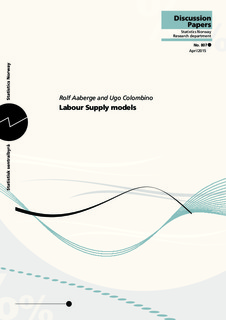Labour Supply models
| dc.contributor.author | Aaberge, Rolf | |
| dc.contributor.author | Colombino, Ugo | |
| dc.date.accessioned | 2019-08-07T10:26:39Z | |
| dc.date.available | 2019-08-07T10:26:39Z | |
| dc.date.issued | 2015-04 | |
| dc.identifier.issn | 1892-753X | |
| dc.identifier.uri | http://hdl.handle.net/11250/2607422 | |
| dc.description.abstract | This paper is published as Chapter 7 of Handbook of Microsimulation Modelling edited by Cathal O’Donoghue, and issued in the series Contributions to Economic Analysis by Emerald Publishing Group. The purpose of the paper is to provide a detailed discussion in relation to the development of the field of labour supply focused microsimulation models and methodological choices. The paper identifies three methodologies for modelling labour supply • The Reduced Form Approach • The Structural “Marginalist” Approach • The Random Utility Maximisation Approach The paper considers issues associated with the reliability of structural models relative to (ex-post) experimental or quasi-experimental analysis. Recognising however the need to undertake ex-ante analysis, it questions, whether there are alternatives to structural models and how can we evaluate structural models and how they are compared with other approaches. The paper then describes approaches to utilising these models for policy simulation in terms of producing and interpreting simulation outcomes, outlining an extensive literature of policy analyses utilising the approach. Also labour supply is not only central to modelling behavioural response but also modelling optimal tax-benefit systems, with a focus on a computational approach, given some of the challenges of the theoretical approach. Combining labour supply results with welfare functions enables the social evaluation of policy simulations. Combining welfare functions and labour supply functions, the chapter then identifies how to model socially optimal income taxation. | nb_NO |
| dc.language.iso | eng | nb_NO |
| dc.publisher | Statistisk sentralbyrå | nb_NO |
| dc.relation.ispartofseries | Discussion papers;807 | |
| dc.subject | Inequality | nb_NO |
| dc.subject | Poverty | nb_NO |
| dc.subject | Deprivation | nb_NO |
| dc.subject | Multidimensional well-being | nb_NO |
| dc.subject | Capabilities and functionings | nb_NO |
| dc.subject | JEL classification: D10 | nb_NO |
| dc.subject | JEL classification: D31 | nb_NO |
| dc.subject | JEL classification: H21 | nb_NO |
| dc.subject | JEL classification: H24 | nb_NO |
| dc.subject | JEL classification: J20 | nb_NO |
| dc.title | Labour Supply models | nb_NO |
| dc.type | Working paper | nb_NO |
| dc.description.version | publishedVersion | nb_NO |
| dc.source.pagenumber | 59 s. | nb_NO |
Tilhørende fil(er)
Denne innførselen finnes i følgende samling(er)
-
Discussion Papers [1002]
